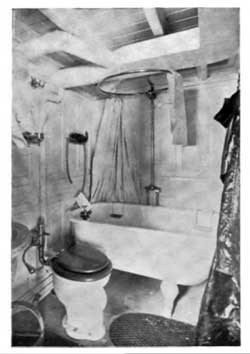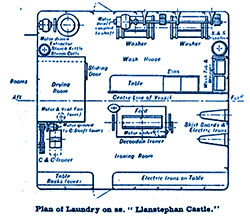Steamship Sanitation Facilities

Bathroom Of Imperial Suite On The Steamship Amerika. Domestic Engineering, 20 October 1906. GGA Image ID # 21f610b294

Steamship Certificate of Health - 1904
The 1904 Steamship Certificate of Health is a historically significant document that provides insight into sanitation regulations, maritime health practices, and early public health measures in ocean travel. This certificate, issued in Havre, France, verifies that the French steamship Campinas underwent cleaning, scraping, and fumigation after unloading its cargo. It confirms that the vessel was free of any contamination before taking on new cargo and passengers.
First Successful Steamship Laundry (1905)
The introduction of a fully operational steam laundry aboard the White Star Line’s SS Celtic in 1905 marked a groundbreaking advancement in ocean travel, reshaping the experience for passengers and crew alike. This article provides a detailed and vivid account of how the first-ever onboard laundry plant revolutionized maritime hygiene and comfort. It describes not only the logistics and machinery behind this innovation but also its impact on passenger convenience, steamship operations, and maritime sanitation.

Bathing on a Steamship - Article and Photographs (1906)
This 1906 article on shipboard bathing provides a fascinating glimpse into the evolution of hygiene and bathing facilities on ocean liners and sailing vessels, contrasting luxury accommodations with the harsh realities of crew and steerage passengers. It highlights the growing emphasis on cleanliness aboard ships, particularly among first-class passengers, while acknowledging the continued hardships faced by lower-class travelers and sailors.

The Sanitation of a Modern Ocean Liner (1911)
This 1911-1912 article on ocean liner sanitation is a fascinating exploration of how shipboard hygiene, ventilation, and sanitation facilities evolved from the unsanitary conditions of 19th-century ships to the highly advanced and luxurious standards of early 20th-century transatlantic liners like the RMS Olympic. It provides valuable insights into how ocean liners became floating cities with advanced ventilation systems, private and public baths, waste disposal solutions, and even luxurious gymnasiums and Turkish baths.

Sanitation and Safety of Passenger Vessels (1911)
This 1911 article on ocean liner sanitation and safety provides an insightful look into how passenger ships evolved into safer and more sanitary environments, particularly for transatlantic and Pacific voyages. It highlights the significant advances in hygiene, disease prevention, fire safety, and ship design, showing how ocean travel became as safe—or safer—than rail travel during this period.

Bathing Facilities of the Modern Steamship - 1913
This 1913 article by Day Allen Willey provides a fascinating historical perspective on the rapid improvements in bathing facilities aboard ocean liners, highlighting how steamships evolved into floating hotels with luxurious, hotel-like amenities. The comparison between early 20th-century bathing facilities and those from just a decade earlier showcases the technological and social progress in ocean travel, particularly in hygiene, passenger comfort, and class distinctions.
Recap & Summary of the Steamship Sanitation Facilities Index Page
The Steamship Sanitation Facilities index page presents a fascinating collection of historical articles and images that detail the evolution of hygiene, sanitation, and passenger comfort aboard ocean liners from the late 19th to the early 20th century. This section is a valuable resource for teachers, students, genealogists, historians, and maritime enthusiasts, as it provides insight into public health measures, social class distinctions, and technological advancements in ocean travel.
By exploring sanitation certificates, onboard laundry innovations, first-class bathing luxuries, and public health regulations, these articles paint a vivid picture of how ocean liners transformed from unhygienic vessels into floating hotels with state-of-the-art amenities.
Key Highlights & Most Interesting Content
1. Steamship Certificate of Health - 1904
📜 Insight into Early Maritime Sanitation Laws & Public Health Regulations
This 1904 health certificate, issued in Havre, France, verifies that the French steamship Campinas was thoroughly cleaned, scraped, and fumigated before receiving new cargo and passengers.
📖 Why It’s Interesting:
- It provides evidence of early health and safety regulations in the maritime industry, showcasing the growing emphasis on disease prevention in ocean travel.
- The certificate’s dual-language format (Spanish & French) highlights the international nature of maritime trade and travel.
- For genealogists, this document demonstrates the sanitation requirements ships had to meet before carrying passengers, particularly immigrants arriving in the U.S. and other destinations.
🔎 Why It’s Useful:
- Historians can analyze it as an early public health regulation in international shipping.
- Genealogists can reference such documents when researching passenger conditions aboard ships.
- Students can compare 20th-century maritime sanitation laws to modern cruise industry regulations.
2. First Successful Steamship Laundry - 1905
🧺 A Game-Changer for Hygiene and Passenger Comfort
The SS Celtic (White Star Line) became the first ocean liner to feature a fully operational steam laundry plant in 1905, revolutionizing maritime hygiene.
📖 Why It’s Interesting:
- Laundry was a significant challenge on transatlantic voyages, as passengers previously had to hand-wash their garments or wait until port.
- The onboard steam laundry featured industrial washing machines, dryers, and ironing equipment, operated by a team of 40 skilled workers.
- This innovation significantly improved sanitation, reduced passengers’ reliance on bringing excessive clothing, and enhanced crew uniform cleanliness.
🔎 Why It’s Useful:
- For maritime historians, this shows the intersection of technology, convenience, and sanitation in the early 20th century.
- For teachers, this can be part of a broader discussion on industrial advancements and their impact on daily life.
- For genealogists, this provides insight into the conditions that ancestors traveling in different classes may have experienced—first-class passengers had their laundry done onboard, while steerage passengers likely had to wait until they arrived at their destination.
3. Bathing on a Steamship - 1906
🚿 Luxury vs. Necessity: Hygiene for Different Classes at Sea
This 1906 article explores the stark contrast between first-class bathing facilities and the limited hygiene options for steerage passengers and crew members.
📖 Why It’s Interesting:
- The SS Amerika (Hamburg-American Line) featured lavish bathrooms in its first-class suites, equipped with onyx-walled bathtubs, electric lighting, and hot & cold water.
- Steerage passengers had far more limited options, often relying on public washrooms or simple basins for personal hygiene.
- Sailors and engine room workers had even fewer opportunities to bathe, often resorting to washing with rainwater.
🔎 Why It’s Useful:
- For social historians, this highlights the dramatic class distinctions aboard ocean liners.
- For educators, it provides a compelling comparison to today’s cruise industry, where even budget travelers have access to private showers.
- For genealogists, it offers insight into the hygiene conditions that ancestors might have endured while traveling to America or other destinations.
4. The Sanitation of a Modern Ocean Liner - 1911
🚢 How Ships Became Floating Cities with Advanced Hygiene Systems
This 1911-1912 article examines the technological advancements in ventilation, waste management, and passenger hygiene aboard the RMS Olympic, one of the largest and most advanced liners of its time.
📖 Why It’s Interesting:
- The Olympic featured an elaborate ventilation system, ensuring fresh air reached every part of the ship, including steerage compartments.
- Electric fans replaced traditional wind funnels, making the ship’s interior more comfortable and sanitary.
- Public baths, Turkish baths, and gymnasiums introduced new standards of cleanliness and wellness for first-class passengers.
🔎 Why It’s Useful:
- For maritime engineers, this article details the technological innovations that shaped modern cruise ships.
- For students and teachers, it shows how competition among steamship companies led to advancements in passenger comfort.
- For genealogists, it offers a glimpse into the travel conditions of early 20th-century immigrants and passengers.
5. Sanitation and Safety of Passenger Vessels - 1911
⚓ A Turning Point in Maritime Safety and Hygiene
This 1911 article discusses how safety and sanitation evolved alongside shipbuilding advancements, making ocean travel as safe—if not safer—than land travel.
📖 Why It’s Interesting:
- The article details the impact of wireless telegraphy on maritime safety, allowing ships to communicate distress signals.
- It describes the role of fire detection systems, watertight bulkheads, and better lifeboat procedures in preventing disasters.
- The sanitation facilities aboard the SS Minnesota (Pacific Ocean service) were highlighted as an example of best practices, including mechanically ventilated lavatories, private baths, and an onboard medical team.
🔎 Why It’s Useful:
- For historians, this highlights the intersection of hygiene and safety in maritime travel.
- For educators, it offers a great discussion topic about the evolution of travel safety before and after the Titanic disaster (1912).
- For genealogists, it explains how sanitation policies impacted the health and survival rates of immigrant passengers.
6. Bathing Facilities of the Modern Steamship - 1913
🛁 The Final Step Toward Luxury Ocean Travel
This 1913 article by Day Allen Willey explores how bathing facilities aboard ocean liners became comparable to luxury hotels, marking the final step toward the modern cruise experience.
📖 Why It’s Interesting:
- By 1913, even second-class and some steerage passengers had access to public baths.
- Ships introduced full-size swimming pools, Turkish baths, and electric light baths, making bathing an enjoyable onboard activity.
- Staterooms with private baths became the most in-demand accommodations, setting the stage for the ensuite bathrooms on today’s cruise ships.
🔎 Why It’s Useful:
- For historians and maritime enthusiasts, it illustrates the transition from necessity-based hygiene to leisure-based bathing.
- For students, it provides an example of how industries evolve based on consumer demand.
- For genealogists, it offers insights into how different social classes experienced ocean travel.
Final Thoughts: The Evolution of Sanitation & Hygiene at Sea
The Steamship Sanitation Facilities index is a treasure trove of maritime history, documenting the incredible progress in hygiene, sanitation, and passenger comfort from the late 19th century to the early 20th century. These articles showcase how ocean travel transformed from a potentially dangerous, unsanitary experience into a luxurious and safe journey.
✔ For teachers & students, it’s a perfect case study in industrial progress and public health.
✔ For genealogists, it provides crucial context on the travel conditions of ancestors.
✔ For maritime historians, it illustrates the technological innovations that laid the foundation for modern cruise ships.
Ultimately, these sanitation advancements not only improved passenger experiences but also played a vital role in shaping the future of transatlantic travel and global migration.

